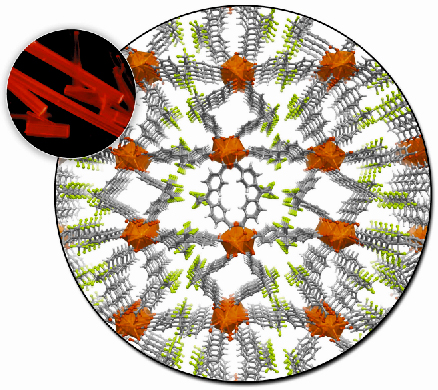- Home
- Users & Science
- Scientific Documentation
- ESRF Highlights
- ESRF Highlights 2008
- Materials science
- Metal-organic nanoporous structures as photoluminescent chemical sensors
Metal-organic nanoporous structures as photoluminescent chemical sensors
The field of multifunctional materials has seen rapid progress with the discovery of structures which combine a set of well-defined properties for specific applications within the same crystal. Properties such as nanoporosity, luminescence, and magnetism are required for sensors, lasers, nonlinear optics, displays, and electroluminescent devices. Lanthanide-based porous metal-organic frameworks (Ln-MOFs) can possess some of these properties and are therefore excellent candidates for such multifunctional materials for sensors. However, the pore sizes of most known Ln-MOF materials are too small to allow the diffusion of molecules of interest, precluding their use in photoluminescence sensors.
Recently, we designed and synthesised two novel crystalline MOFs containing rare-earth cations that combine microporous structure, hydrophobicity, high adsorption capacity, high thermal resistance, anisotropic photoluminescence and magnetic properties.
The key design element of the MOFs was the inclusion of the organic spacer, 4,4'-(hexafluoroisopropylidene)-bis(benzoic acid) (HFIPBB). This molecule has high hydrophobicity because of the presence of aromatic rings and -CF3 groups, an antenna effect from its aromatic groups, strong interaction with the metal centre through the carboxylic groups, and two coordination centres that are required for the microporous 3D structure. The chosen metal atoms were any single lanthanide (except radioactive promethium), or mixtures of them. Two new materials, named “ITQMOF-1” and “ITQMOF-2”, were obtained with similar composition but different crystal structures.
The structure of ITQMOF-1 could not be solved due to severe twinning, although it has been recently described by another Spanish group [1]; the structure of ITQMOF-2 was solved using single crystal data collected at the beamline BM16 (Figure 44).
 |
|
Fig. 44: Crystal structure of ITQMOF-2 (C grey, F yellow: H white, O red, Eu orange). Upper-left inset: Eu3+-containing ITQMOF-2 crystals under UV light. |
Both materials are insoluble in water and in common organic solvents, and have excellent thermal stability; powder XRD of samples heated in situ reveals that ITQMOF-1 is stable in air at temperatures above 400ºC, and decomposes at ca. 450ºC.
To demonstrate the potential applications of these materials in sensor devices, Eu3+-containing ITQMOF-1 was used for detecting the presence of ethanol in air. This was done by monitoring the emission at 619 nm under alternating streams of air saturated with ethanol and ethanol-free air. In the presence of ethanol, we observed a rapid decrease of the emission intensity, which recovers rapidly when the material is exposed to clean air. This behaviour may be explained by considering that ethanol coordinates the Ln3+ ions, quenching the photoemission through coupling with the vibrational states of the O-H oscillators. The addition of water to both streams did not modify these results, confirming the interest of the hydrophobic properties of the materials for measuring ethanol in a water-containing air stream.
Importantly, it is possible to obtain materials with different emission colours and magnetic properties by carefully selecting the Ln3+ ions. For example, Tb3+-ITQMOF-1 presents a ferromagnetic interaction between the metal ions and a strong green emission in UV light, while Eu3+-ITQMOF-2 exhibits a red colour in UV light (Figure 44, inset) with paramagnetic interactions. Moreover, the (5% Eu3+ - 95% Gd3+)-ITQMOF-1 sample shows an antiferromagnetic interaction between the Gd3+ ions, and a red colour in UV light due to the Eu3+ ions. Remarkably, this material presents both a 5D0 quantum efficiency q = 0.83 (to our knowledge, the largest reported for solid-state Eu3+ compounds with organic ligands) and the largest value of absolute emission quantum yield (![]() = 0.48, excitation wavelength of 290 nm) reported for Eu3+-based MOFs. Furthermore, this emission is highly anisotropic, depending on the orientation of the crystals relative to the incident beam and the detector.
= 0.48, excitation wavelength of 290 nm) reported for Eu3+-based MOFs. Furthermore, this emission is highly anisotropic, depending on the orientation of the crystals relative to the incident beam and the detector.
In conclusion, we show that a judicious choice of the ligand (HFIPBB) allowed the design of novel lanthanide-based metal-organic frameworks with high thermal stability and interesting multifunctional properties (magnetism, luminescence, microporosity and hydrophobicity). The combination of photoluminescent Ln3+ centres and HFIPBB resulted in materials which efficiently sense ethanol, even in the presence of water and under ambient conditions. Current studies are now focused on exploring the combination of optical and magnetic properties for sensor applications and data storage.
Principal publication and authors
B.V. Harbuzaru (a), A. Corma (a), F. Rey (a), P. Atienzar (a), J.L. Jordá (a), H. García (a), D. Ananias (b), L.D. Carlos (b), J. Rocha (b), Angewandte Chemie International Edition, 47, 1080 (2008).
(a) Instituto de Tecnología Química, (UPV-CSIC), Valencia (Spain)
(b) Departments of Chemistry and Physics, CICECO, University of Aveiro (Portugal)
Reference
[1] F. Gándara, A. de Andrés, B. Gómez-Lor, E. Gutiérrez-Puebla, M. Iglesias, M.A. Monge, D.M. Proserpio, N. Snejko, Crystal Growth & Design, 8, 378 (2008).



